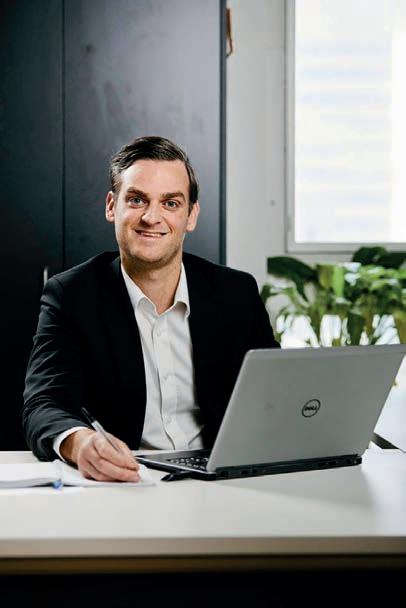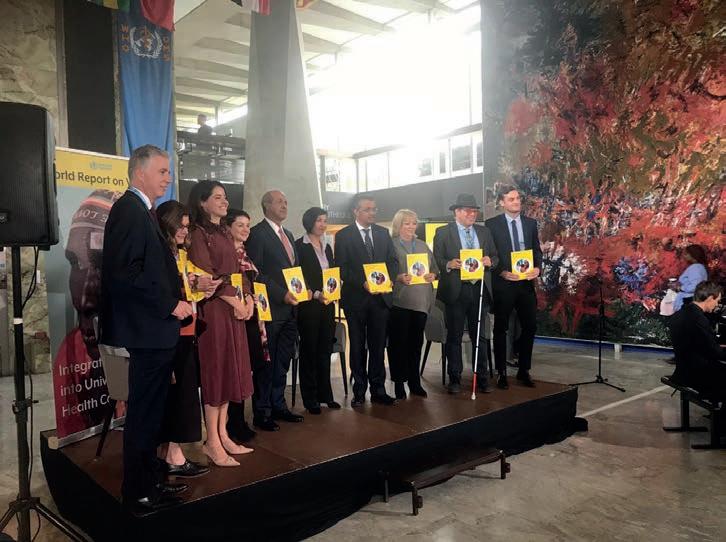
4 minute read
ORTHOPTICS AUSTRALIA
from Insight May 2022
by Prime Group
AN AUSSIE ORTHOPTIST WORKING IN GLOBAL PUBLIC HEALTH
STUART KEEL BECAME INTERESTED IN PUBLIC HEALTH WHILE WITNESSING STARK EYE HEALTH INEQUALITIES AS PART OF THE FIRST NATIONAL EYE HEALTH SURVEY. THE EXPERIENCE HAS TAKEN HIS CAREER TO THE HEADQUARTERS OF THE WHO.
STUART KEEL

“THE BEAUTY OF THIS PROFESSION LIES IN THE COUNTLESS OPPORTUNITIES WE HAVE TO CONTRIBUTE IN WAYS THAT ALIGN WITH OUR VALUES” I ’m an Australian orthoptist currently working as a technical officer within the Vision and Eye Care Programme at the World Health Organization (WHO), Geneva. In this role, I support the development of technical guidance and tools that aim to assist countries to strengthen the delivery of eyecare within their health systems.
My eyecare journey began at La Trobe University in Melbourne where I completed a Bachelor’s Degree in Orthoptics and Ophthalmic Science. After several years working as an orthoptist within a range of public and private clinical settings in Australia, I ventured back to where it all started, La Trobe University, to embark on a PhD in ophthalmic epidemiology. While undertaking this, I had the opportunity to be involved in the education of orthoptic students and held positions with Orthoptics Australia, including honorary president of the Victorian branch.
My interest in public health began when I joined the Centre for Eye Research Australia (CERA) as a post-doc fellow where, during travels around Australia as part of the National Eye Health Survey, I witnessed first-hand the stark eye health inequalities experienced by many segments of the national population, including the Indigenous population and those living in rural and remote communities. As an active member of the CERA-WHO Collaborating Centre for Prevention of Blindness, I benefitted from exposure to projects on international eyecare, such as working with WHO Western Pacific Office in Manila to evaluate progress at the mid-point of the ‘Universal Eye Health: a Global Action Plan 2014-2019’.
After several years working in academia, I commenced a position within WHO’s headquarters in Geneva as a technical officer for the Vision and Eye Care Programme in 2019. This represented an exciting time to be involved in global public health in the field of eyecare; the year 2020 marked the end of WHO’s global initiative ‘Vision 2020: The Right to Sight’, and new strategies were being discussed to address the current and projected population eyecare needs.
Since 2019, the Vison and Eye Care
Stuart Keel (far right) at the launch of the ‘World report on vision’ with the World Health Organization director general Dr Tedros Adhanom Ghebreyesus (fourth from right) and others.
Programme at WHO has played a role in several key developments that have helped shape the new eyecare agenda for the coming decade, including: I. Producing WHOs first World report on vision (2019) that sets forth several actions that governments, nonstate actors and WHO can take to address the key challenges facing the eyecare sector; II. The resolution titled: ‘Integrated peoplecentered eyecare, including preventable vision impairment and blindness’, that was endorsed by member states at the 73rd World Health Assembly (WHA73.4) in 2020; III. Preparation of recommendations on global targets for 2030 focusing on two global tracer eyecare indicators, effective coverage of cataract surgery and refractive error, that were subsequently endorsed by the 74th World Health
Assembly in May 2021.
To support countries with the implementation of the actions outlined in these high-level documents and global commitments, the WHO team in which I work with other international experts, has developed a range of technical tools that will be launched in 2022.
Some of which include (i) a package of evidence-based eyecare interventions to assist countries in making decisions on which interventions to prioritise and how these can be budgeted at each level of care; (ii) an eyecare competency framework to assist in workforce planning and development; and (iii) an eyecare indicators menu and resources to facilitate data collection to ensure robust monitoring of progress towards achieving these new proposed actions and targets
When I started my career as an orthoptist, never did I imagine it would lead me to the head office of the world’s leading public health agency. However, the beauty of this profession lies in the countless opportunities we have to contribute in ways that align with our values and personal purpose. I hope my journey helps to inspire other orthoptists to continue their meaningful and important work, no matter the stage of their career or setting they work in. n
ABOUT THE AUTHOR: Australian-trained orthoptist STUART KEEL is a Technical Officer of the Vision and Eye Care Programme at World Health Organization in Geneva. He has previously been a post-doc fellow at the Centre for Eye Research Australia and honorary president of the Orthoptics Australia Victorian branch.
ORTHOPTICS AUSTRALIA strives for excellence in eye health care by promoting and advancing the discipline of orthoptics and by improving eye health care for patients in public hospitals, ophthalmology practices, and the wider community. Visit: orthoptics.org.au






